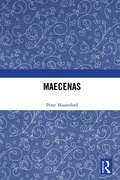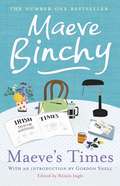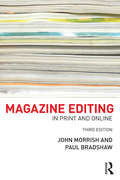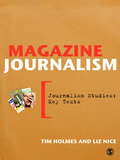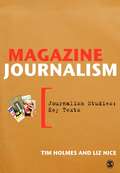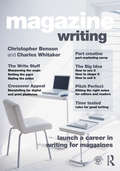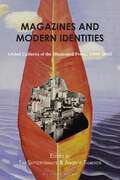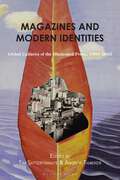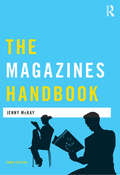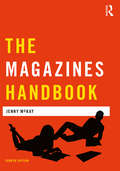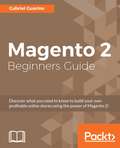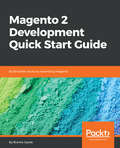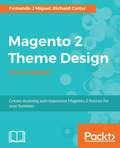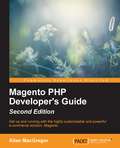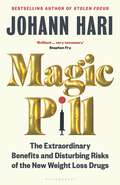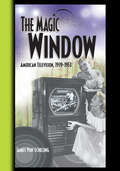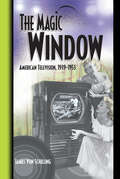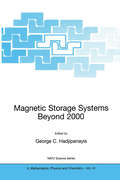- Table View
- List View
Maecenas
by Peter MountfordWhile much has been written of the importance of Agrippa in Augustus’ rise to power as the first emperor of Rome, Maecenas remains a shadowy figure despite being a vital part in the success of Augustus. After the assassination of Julius Caesar, Maecenas was a vital negotiator between Octavian and Mark Antony in the years leading up to the battle of Actium, and a wise political advisor to Augustus during the early years of the new regime. This is the first biography of Maecenas in English and gives due credit to the stature of Maecenas both as a confidant of the emperor and as patron of the poets Virgil, Horace and Propertius. The book devotes a chapter to each poet’s relationship with Maecenas and the Augustan regime: the chapter on Virgil, while considering his relationship to Maecenas and Augustus, argues that the origins of his choice of Aeneas may lie in Etruria rather than elsewhere, while the chapter on Horace assesses one of the closest documented relationships of Roman history. The chapter on Propertius wrestles with the disparate views of scholars on the question of his relationship with the Augustan regime and argues that, at heart, he remains an Umbrian/Etruscan rather than a Roman. A crucial feature of the book is the provision of 161 texts from ancient Roman and Greek authors which mention Maecenas. Based on sustainable evidence this study of the importance of Maecenas takes scholarship in new and important directions.
Maeve's Times: In Her Own Words
by Maeve Binchy'Maeve's Times is funny and clever and kind, which are excellent qualities in both books and people' Irish Times'As someone who fell off a chair not long ago trying to hear what they were saying at the next table in a restaurant, I suppose I am obsessively interested in what some might consider the trivia of other people's lives.'Maeve Binchy is well known for her bestselling novels, but for many years Maeve was a journalist. From 'The Student Train' to 'Plane Bores' and 'Bathroom Joggers' to 'When Beckett met Binchy', these articles have all the warmth, wit and humanity of her fiction. Arranged in decades, from the 1960s to the 2000s, and including Maeve's first and last ever piece of writing for the Irish Times, the columns also give a fascinating insight into the author herself.With an introduction written by her husband, the writer Gordon Snell, this collection of timeless writing reminds us of why the leading Irish writer was so universally loved.
Magazine Editing: In Print and Online
by Paul Bradshaw John MorrishIncluding comprehensive coverage on both print and online, consumer and free magazines, Magazine Editing looks at how magazines work and explains the dual role of the magazine editor. John Morrish and Paul Bradshaw consider the editor both as a journalist, having to provide information and entertainment for readers, and as a manager, expected to lead and supervise successfully the development of a magazine or periodical. Looking at the current state of the magazine market in the twenty-first century, the third edition explains how this has developed and changed in recent years, with specific attention paid to the explosion of apps, e-zines, online communities and magazine websites. Featuring case studies, interviews with successful editors, examples of covers and spreads, and useful tables and graphs, this book discusses the editor’s many roles and details the skills needed to run a publication. Magazine Editing offers practical guidance on: how to create an editorial strategy how to lead and manage an editorial team researching a market and finding new readers dealing with budgets and finance working with designers and production staff legal, technological and ethical dilemmas online distribution, social media and search engine optimisation managing information overload how to become an editor.
Magazine Editing: In Print and Online
by Paul Bradshaw John MorrishIncluding comprehensive coverage on both print and online, consumer and free magazines, Magazine Editing looks at how magazines work and explains the dual role of the magazine editor. John Morrish and Paul Bradshaw consider the editor both as a journalist, having to provide information and entertainment for readers, and as a manager, expected to lead and supervise successfully the development of a magazine or periodical. Looking at the current state of the magazine market in the twenty-first century, the third edition explains how this has developed and changed in recent years, with specific attention paid to the explosion of apps, e-zines, online communities and magazine websites. Featuring case studies, interviews with successful editors, examples of covers and spreads, and useful tables and graphs, this book discusses the editor’s many roles and details the skills needed to run a publication. Magazine Editing offers practical guidance on: how to create an editorial strategy how to lead and manage an editorial team researching a market and finding new readers dealing with budgets and finance working with designers and production staff legal, technological and ethical dilemmas online distribution, social media and search engine optimisation managing information overload how to become an editor.
Magazine Journalism
by Liz Nice Tim Holmes"For those of us who long ago experienced the magazine love-bite and have been battling the prejudice and scant attention shown this beautiful medium ever since, here at last is the book to set the record straight." - Nicholas Brett, Deputy Managing Director, BBC Magazines "At a time when magazines are undergoing active redefinition, this book represents a welcome intervention. It engages with a host of pressing issues in a manner alert to professional priorities while, at the same time, encouraging new ways of thinking about the challenges shaping this fast-moving field. Holmes and Nice are trustworthy guides, taking the reader on what proves to be a fascinating journey." - Stuart Allan, Professor of Journalism, Bournemouth University Magazines are the most successful media format ever to have existed: so begins Magazine Journalism as it traces how magazines arose from their earliest beginnings in 1665 to become the ubiquitous format we know today. This book combats the assumptions among media academics as well as journalists that magazines somehow don't count, and presents a compelling assessment of the development and innovation at the heart of magazine publishing. In magazines we find some of the key debates in journalism, from the genesis of 'marketing to the reader' to feminist history, subcultures and tabloidization. Embedding these questions in a thoroughly historical framework, Holmes and Nice argue for an understanding of magazine journalism as essential in the media landscape. Moving beyond the semiotic and textual analysis so favoured by critics of the past, the authors complete the story with an exploration of the production and consumption of magazines. Drawing on interviews with more than 30 magazine journalists across the industry, what emerges is a story of resilience, innovation and a unique ability to embrace new markets and readerships. Magazine Journalism takes the reader to the heart of key questions in the past, present and future of journalism and is essential reading for students across journalism and the creative industries.
Magazine Journalism (PDF)
by Liz Nice Tim Holmes"For those of us who long ago experienced the magazine love-bite and have been battling the prejudice and scant attention shown this beautiful medium ever since, here at last is the book to set the record straight." - Nicholas Brett, Deputy Managing Director, BBC Magazines "At a time when magazines are undergoing active redefinition, this book represents a welcome intervention. It engages with a host of pressing issues in a manner alert to professional priorities while, at the same time, encouraging new ways of thinking about the challenges shaping this fast-moving field. Holmes and Nice are trustworthy guides, taking the reader on what proves to be a fascinating journey." - Stuart Allan, Professor of Journalism, Bournemouth University Magazines are the most successful media format ever to have existed: so begins Magazine Journalism as it traces how magazines arose from their earliest beginnings in 1665 to become the ubiquitous format we know today. This book combats the assumptions among media academics as well as journalists that magazines somehow don't count, and presents a compelling assessment of the development and innovation at the heart of magazine publishing. In magazines we find some of the key debates in journalism, from the genesis of 'marketing to the reader' to feminist history, subcultures and tabloidization. Embedding these questions in a thoroughly historical framework, Holmes and Nice argue for an understanding of magazine journalism as essential in the media landscape. Moving beyond the semiotic and textual analysis so favoured by critics of the past, the authors complete the story with an exploration of the production and consumption of magazines. Drawing on interviews with more than 30 magazine journalists across the industry, what emerges is a story of resilience, innovation and a unique ability to embrace new markets and readerships. Magazine Journalism takes the reader to the heart of key questions in the past, present and future of journalism and is essential reading for students across journalism and the creative industries.
Magazine Writing
by Christopher D. Benson Charles F. WhitakerWhat does it take to launch a career writing for magazines? In this comprehensive, up-to-date introduction to magazine writing, students will learn everything from the initial story pitch all the way through to the final production, taking with them the essential tools and skills they will need for today’s rapidly changing media landscape. Written by a team of experienced writers and editors, Magazine Writing teaches the time-tested rules for good writing alongside the modern tools for digital storytelling. From service pieces to profiles, entertainment stories and travel articles, it provides expert guidance on topics such as: developing saleable ideas; appealing to specific segments of the market; navigating a successful pitch; writing and editing content for a variety of areas, including service, profiles, entertainment, travel, human interest and enterprise Chock full of examples of published works, conversations with successful magazine contributors and bloggers, and interviews with working editors, Magazine Writing gives students all the practical and necessary insights they need to jumpstart a successful magazine writing career.
Magazine Writing
by Christopher D. Benson Charles F. WhitakerWhat does it take to launch a career writing for magazines? In this comprehensive, up-to-date introduction to magazine writing, students will learn everything from the initial story pitch all the way through to the final production, taking with them the essential tools and skills they will need for today’s rapidly changing media landscape. Written by a team of experienced writers and editors, Magazine Writing teaches the time-tested rules for good writing alongside the modern tools for digital storytelling. From service pieces to profiles, entertainment stories and travel articles, it provides expert guidance on topics such as: developing saleable ideas; appealing to specific segments of the market; navigating a successful pitch; writing and editing content for a variety of areas, including service, profiles, entertainment, travel, human interest and enterprise Chock full of examples of published works, conversations with successful magazine contributors and bloggers, and interviews with working editors, Magazine Writing gives students all the practical and necessary insights they need to jumpstart a successful magazine writing career.
Magazines and Modern Identities: Global Cultures of the Illustrated Press, 1880–1945
by Tim Satterthwaite and Andrew ThackerIn the late nineteenth and early twentieth century, ideals of technological progress and mass consumerism shaped the print cultures of countries across the globe. Magazines in Europe, the USA, Latin America, and Asia inflected a shared internationalism and technological optimism. But there were equally powerful countervailing influences, of patriotic or insurgent nationalism, and of traditionalism, that promoted cultural differentiation. In their editorials, images, and advertisements magazines embodied the tensions between these domestic imperatives and the forces of global modernity.Magazines and Modern Identities explores how these tensions played out in the magazine cultures of ten different countries, describing how publications drew on, resisted, and informed the ideals and visual forms of global modernism. Chapters take in the magazines of Australia, Europe and North America, as well as China, The Soviet Turkic states, and Mexico. With contributions from leading international scholars, the book considers the pioneering developments in European and North American periodicals in the modernist period, whilst expanding the field of enquiry to take in the vibrant magazine cultures of east Asia and Latin America. The construction of these magazines' modern ideals was a complex, dialectical process: in dialogue with international modernism, but equally responsive to their local cultures, and the beliefs and expectations of their readers. Magazines and Modern Identities captures the diversity of these ideals, in periodicals that both embraced and criticised the globalised culture of the technological era.
Magazines and Modern Identities: Global Cultures of the Illustrated Press, 1880–1945
In the late nineteenth and early twentieth century, ideals of technological progress and mass consumerism shaped the print cultures of countries across the globe. Magazines in Europe, the USA, Latin America, and Asia inflected a shared internationalism and technological optimism. But there were equally powerful countervailing influences, of patriotic or insurgent nationalism, and of traditionalism, that promoted cultural differentiation. In their editorials, images, and advertisements magazines embodied the tensions between these domestic imperatives and the forces of global modernity.Magazines and Modern Identities explores how these tensions played out in the magazine cultures of ten different countries, describing how publications drew on, resisted, and informed the ideals and visual forms of global modernism. Chapters take in the magazines of Australia, Europe and North America, as well as China, The Soviet Turkic states, and Mexico. With contributions from leading international scholars, the book considers the pioneering developments in European and North American periodicals in the modernist period, whilst expanding the field of enquiry to take in the vibrant magazine cultures of east Asia and Latin America. The construction of these magazines' modern ideals was a complex, dialectical process: in dialogue with international modernism, but equally responsive to their local cultures, and the beliefs and expectations of their readers. Magazines and Modern Identities captures the diversity of these ideals, in periodicals that both embraced and criticised the globalised culture of the technological era.
The Magazines Handbook
by Jenny McKayThe Magazines Handbook has firmly established itself as the essential introduction to the theories and practices of the modern magazine industry. This fully updated third edition comprehensively examines the business of publishing magazines today and the work of the contemporary magazine journalist. Jenny McKay draws examples from a broad range of publications to explore key jobs in the industry, covering everyone from the sub editor to the fashion assistant, as well as analysing the many skills involved in magazine journalism, including commissioning, researching, interviewing, and production. Updated specialist chapters discuss the growth and development of electronic publishing and online journalism, new directions in magazine design, photography and picture editing, and the most up to date legal frameworks in which magazine journalists must operate. The Magazines Handbook includes: • Interviews with magazine journalists, editors, and publishers • Advice on starting out and freelancing in the magazine industry • An analysis of ‘new journalism’ and reportage • A glossary of key terms and specialist concepts • Information on contacts, courses and professional training.
The Magazines Handbook
by Jenny McKayThe Magazines Handbook has firmly established itself as the essential introduction to the theories and practices of the modern magazine industry. This fully updated third edition comprehensively examines the business of publishing magazines today and the work of the contemporary magazine journalist. Jenny McKay draws examples from a broad range of publications to explore key jobs in the industry, covering everyone from the sub editor to the fashion assistant, as well as analysing the many skills involved in magazine journalism, including commissioning, researching, interviewing, and production. Updated specialist chapters discuss the growth and development of electronic publishing and online journalism, new directions in magazine design, photography and picture editing, and the most up to date legal frameworks in which magazine journalists must operate. The Magazines Handbook includes: • Interviews with magazine journalists, editors, and publishers • Advice on starting out and freelancing in the magazine industry • An analysis of ‘new journalism’ and reportage • A glossary of key terms and specialist concepts • Information on contacts, courses and professional training.
The Magazines Handbook (Media Practice)
by Jenny McKayThe Magazines Handbook is an introductory guide to all aspects of magazine journalism and publishing. The book explores the latest innovations in digital design and delivery, whilst also reaffirming the continued importance of key journalistic skills, including good interviewing, feature writing and news writing. The book includes chapters on the visual aspects of magazines, such as illustration and picture editing, and chapters covering the business background of this increasingly global industry. Jenny McKay offers tips on training and work experience as well as outlining the function of various editorial jobs. Profiles of four young journalists give a flavour of life in the early years of a career. Chapters include: advice on embarking on a career in magazine journalism; an overview of magazine design and the production process; analysis of the state of the magazine industry today, with a look to its future; a discussion of legal issues related to magazine journalism; a glossary of key terms and recommended reading in every chapter. Now in its fourth edition, The Magazines Handbook offers a nuanced and reflective account of periodical journalism, ideal for students of journalism and budding professionals who are seeking a useful starting point for wide-ranging academic discussion about magazines.
The Magazines Handbook (Media Practice)
by Jenny McKayThe Magazines Handbook is an introductory guide to all aspects of magazine journalism and publishing. The book explores the latest innovations in digital design and delivery, whilst also reaffirming the continued importance of key journalistic skills, including good interviewing, feature writing and news writing. The book includes chapters on the visual aspects of magazines, such as illustration and picture editing, and chapters covering the business background of this increasingly global industry. Jenny McKay offers tips on training and work experience as well as outlining the function of various editorial jobs. Profiles of four young journalists give a flavour of life in the early years of a career. Chapters include: advice on embarking on a career in magazine journalism; an overview of magazine design and the production process; analysis of the state of the magazine industry today, with a look to its future; a discussion of legal issues related to magazine journalism; a glossary of key terms and recommended reading in every chapter. Now in its fourth edition, The Magazines Handbook offers a nuanced and reflective account of periodical journalism, ideal for students of journalism and budding professionals who are seeking a useful starting point for wide-ranging academic discussion about magazines.
Magazinjournalismus im Fernsehen: Ein Handbuch für Ausbildung und Praxis (Journalistische Praxis)
by Kim Otto Claudio Höll Andreas ElterDas Trainingshandbuch Magazinjournalismus Fernsehen gibt Journalismusstudierenden und Journalistinnen und Journalisten einen Leitfaden zur Produktion eines Fernsehmagazinbeitrags an die Hand. Mit Praxisbeispielen wird gezeigt, wie Magazinjournalismus gelingt, der seine Zuschauer bannt und informiert und so Teil der öffentlichen Debatte wird. Das Trainingshandbuch fokussiert sich auf die Praxis: Von der Themenrecherche über Interviewtechniken bis zum fertigen Beitrag begleitet das Buch Sie in allen Schritten zu Ihrem Fernsehmagazinbeitrag.
Magento 2 Beginners Guide
by Gabriel GuarinoDiscover what you need to know to build your own profitable online stores using the power of Magento 2! About This Book • Set up and manage your very first online store with a friendly and engaging approach using Magento 2 • Create your own shipping rates matrix and connect to shippers such as UPS, FedEx, and USPS • Create reports to track store sales, customer activity, and statistics Who This Book Is For Have you been trying to create a website without luck using different platforms, but have never tried Magento before? Then this book is for you. Familiarity with programming and Magento 1 will help, but is not a prerequisite. What You Will Learn • Build your first web store in Magento 2 • Migrate your development environment to a live store • Configure your Magento 2 web store the right way, so that your taxes are handled properly • Create pages with arbitrary content • Create and manage customer contacts and accounts • Protect Magento instance admin from unexpected intrusions • Set up newsletter and transactional emails so that communication from your website corresponds to the website's look and feel • Make the store look good in terms of PCI compliance In Detail Do you have a good product to sell but need your start-up to sell it to your potential customers the right way? Were you unhappy with what Magento 1 had to offer and are looking forward to trying out what Magento 2 provides? If either of these questions ring a bell, then this book is for you! You'll start by getting a general understanding of what Magento is, why and how you should use it, and whether it is possible and feasible to migrate from an old web store to Magento 2. We'll introduce you to the main e-commerce concepts and basic features and let you play with them, so you can get a taste of how catalog and content management works. Following on from that, we'll show you how to tune your store up. You will learn how to get web store offers up and running, how to offer various discounts in the catalog, how to let the customers reduce the total price in the shopping cart by combining different products, and how to generate coupon codes that customers can use. Finally, we'll get serious and turn your plaything into a real web store, teaching you how to run it for real. Style and approach This book is a step-by-step guide to creating your first online store from scratch using Magento 2.
Magento 2 Development Quick Start Guide: Build better stores by extending Magento
by Branko AjzeleCreate an interactive online store and customize it further using Magento Key Features Straightforward guide to developing with Magento Examples of different types of extension Customize the Magento storefront and admin areas Book Description Magento is an open source, enterprise-level e-commerce platform with unlimited scope for customization. This makes it a great choice not only for vendors, but for developers as well. This book guides you through Magento development, teaching you how to develop modules that extend or change its functionality, leading to more flexible and proftable Magento stores. You start with a structural overview of the key Magento development components. You will learn where things such as plugins, events, models, controllers, layouts, and UI components ft into the development landscape. You will go through examples of using these components to extend Magento. As you progress, you will be building a diverse series of small but practical Magento modules. By the end of this book, you will not only have a solid foundation in the Magento development architecture; you will also have practical experience of developing modules to customize and extend Magento stores. What you will learn Develop a simple shipping module Build admin interfaces with the built-in form and listing UI components Implement JavaScript components for improved customer experience Accommodate vendor needs by adding new catalog-related features Develop your way to a better checkout Improve customer interaction with new customer-related extensions Create new web APIs to make your modules more extensible Who this book is for This book is for competent PHP developers, with only basic knowledge of the Magento platform required.
Magento 2 Development Quick Start Guide: Build better stores by extending Magento
by Branko AjzeleCreate an interactive online store and customize it further using Magento Key Features Straightforward guide to developing with Magento Examples of different types of extension Customize the Magento storefront and admin areas Book Description Magento is an open source, enterprise-level e-commerce platform with unlimited scope for customization. This makes it a great choice not only for vendors, but for developers as well. This book guides you through Magento development, teaching you how to develop modules that extend or change its functionality, leading to more flexible and proftable Magento stores. You start with a structural overview of the key Magento development components. You will learn where things such as plugins, events, models, controllers, layouts, and UI components ft into the development landscape. You will go through examples of using these components to extend Magento. As you progress, you will be building a diverse series of small but practical Magento modules. By the end of this book, you will not only have a solid foundation in the Magento development architecture; you will also have practical experience of developing modules to customize and extend Magento stores. What you will learn Develop a simple shipping module Build admin interfaces with the built-in form and listing UI components Implement JavaScript components for improved customer experience Accommodate vendor needs by adding new catalog-related features Develop your way to a better checkout Improve customer interaction with new customer-related extensions Create new web APIs to make your modules more extensible Who this book is for This book is for competent PHP developers, with only basic knowledge of the Magento platform required.
Magento 2 Theme Design - Second Edition
by Fernando J Miguel Richard CarterCreate stunning and responsive Magento 2 themes for your business About This Book • Realize the full potential of theme design in Magento 2 • Design attractive themes for your e-commerce store to make them stand out amongst the crowd • Practical skills and examples ensure you can take what you've learnt to your own projects – limited only by your own creativity! Who This Book Is For This book is for web designers and developers with existing knowledge of CSS, HTML, and XML who wish to create themes for Magento 2. Existing Magento 1.x theme designers who now want to develop themes for Magento 2 will also find this book useful. What You Will Learn • Implement a local development Magento environment • Understand the workings of the Magento theme structure • Edit an existing Magento theme to satisfy your business needs • Create print strategies for the Magento 2.0 theme • Generate specific blocks to improve the Magento 2.0 theme • Explore specific Magento programming Methods to improve the Magento 2.0 theme • Customize the Magento 2.0 admin panel to create a new Magento 2.0 admin theme • Build a Twitter module for Magento 2.0 and integrate Magento 2.0 with social bookmarking In Detail Magento is the e-commerce software and platform trusted by the world's leading brands. Using Magento's powerful theming engine, you can control the look, content, and functionality, and easily launch a flexible e-commerce website. However, because of its powerful features, developing Magento themes is easier said than done. This book aims to leverage the enhancements to theme designing in Magento 2 to the fullest. It will show you how to gear up the performance of your e-commerce website. We begin by introducing Magento 2 and its features along with implementing a local development Magento environment. We then move on to discuss the concepts of the Magento theme structure such as templates, inheritance, customization, and override. Further on, we explore the Magento UI Library, which is a new feature available in Magento 2.0. We will create a new Magento 2.0 theme named MyCake Store using Magento Bootstrap from Maven E-commerce and also create print strategies for the Magento 2.0 theme. We will also create and customize a new theme proposal for the Magento admin panel. At the end, we will integrate Magento 2.0 to Twitter and integrate it with social bookmarking and finally deploy our new Magento 2.0 theme. Style and approach This is a step-by-step guide to customizing the look and feel of your online store by creating stunning and responsive themes from scratch. In addition to creating new themes, the book will also offer guidance on customizing existing themes.
Magento PHP Developer's Guide - Second Edition
by Allan MacGregorThis book is written for PHP developers who are familiar with frameworks such as Zend or CakePHP and want to start developing and working with Magento. No prior knowledge of Magento is required.
Magic Pill: The Extraordinary Benefits and Disturbing Risks of the New Weight Loss Drugs
by Johann HariThe bestselling author of Lost Connections and Stolen Focus takes a revelatory look at the new drugs transforming weight loss as we know it – sharing his personal experience on Ozempic and examining our ability to heal society's dysfunctional relationship with food, weight and our bodies. In January 2023, Johann Hari started to inject himself once a week with Ozempic, one of the new drugs that produces significant weight loss. He wasn't alone – some predictions suggest that in a few years, one in four of the British population will be taking these drugs. While around 80 per cent of diets fail, someone taking one of the new drugs is likely to lose up to a quarter of their body weight in six months. To the drugs' defenders, this is a moment of liberation from a condition that massively increases your chances of diabetes, cancer and an early death. Still, Hari was wildly conflicted. Can these drugs really be as good as they sound? Are they a magic solution – or a magical illusion? Finding the answer to this high-stakes question led him on a journey from Iceland to Minneapolis to Tokyo, and to interview the leading experts in the world on these issues. He found that along with the drugs' massive benefits come twelve significant potential risks. He also learned that these drugs radically challenge what we think we know about shame, willpower and healing. These drugs are about to change our world, for better and for worse. Everybody needs to understand how they work – scientifically, emotionally and culturally. Magic Pill is an essential guide to the revolution that has already begun – and which one leading expert argues could be as transformative as the invention of the smartphone.
Magic Pill: The Extraordinary Benefits and Disturbing Risks of the New Weight Loss Drugs
by Johann HariThe bestselling author of Lost Connections and Stolen Focus takes a revelatory look at the new drugs transforming weight loss as we know it – sharing his personal experience on Ozempic and examining our ability to heal society's dysfunctional relationship with food, weight and our bodies. In January 2023, Johann Hari started to inject himself once a week with Ozempic, one of the new drugs that produces significant weight loss. He wasn't alone – some predictions suggest that in a few years, one in four of the British population will be taking these drugs. While around 80 per cent of diets fail, someone taking one of the new drugs is likely to lose up to a quarter of their body weight in six months. To the drugs' defenders, this is a moment of liberation from a condition that massively increases your chances of diabetes, cancer and an early death. Still, Hari was wildly conflicted. Can these drugs really be as good as they sound? Are they a magic solution – or a magical illusion? Finding the answer to this high-stakes question led him on a journey from Iceland to Minneapolis to Tokyo, and to interview the leading experts in the world on these issues. He found that along with the drugs' massive benefits come twelve significant potential risks. He also learned that these drugs radically challenge what we think we know about shame, willpower and healing. These drugs are about to change our world, for better and for worse. Everybody needs to understand how they work – scientifically, emotionally and culturally. Magic Pill is an essential guide to the revolution that has already begun – and which one leading expert argues could be as transformative as the invention of the smartphone.
The Magic Window: American Television ,1939-1953
by Jim Von SchillingFirst published in 2002. Routledge is an imprint of Taylor & Francis, an informa company.
The Magic Window: American Television ,1939-1953
by Jim Von SchillingFirst published in 2002. Routledge is an imprint of Taylor & Francis, an informa company.
Magnetic Storage Systems Beyond 2000 (NATO Science Series II: Mathematics, Physics and Chemistry #41)
by G. C. HadjipanayisAn up-to-date and comprehensive review of magnetic storage systems, including particulate and rigid media, magnetic heads, tribology, signal processing spintronics, and other, future systems. A thorough theoretical discussion supplements the experimental and technical aspects. Each section commences with a tutorial paper, which is followed by technical discussions of current research in the area. Written at a level suitable for advanced graduate students.
